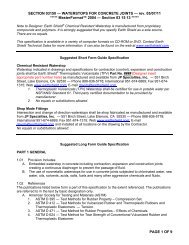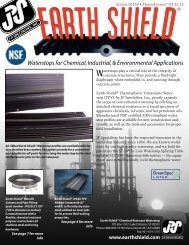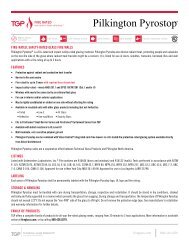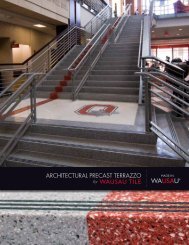National Gypsum Construction Guide
National Gypsum Construction Guide The entire - AECinfo.com
National Gypsum Construction Guide The entire - AECinfo.com
- No tags were found...
Create successful ePaper yourself
Turn your PDF publications into a flip-book with our unique Google optimized e-Paper software.
Design flexibility is achieved with veneer plaster systems.<br />
APPLICATION PROCEDURES<br />
1. Begin application of<br />
Z Furring members by<br />
positioning first channel<br />
vertically at a corner,<br />
locating it on the wall<br />
adjacent to the wall being<br />
insulated first.<br />
The insulation thickness<br />
determines the distance of<br />
Z Furring web from wall<br />
being insulated. At the<br />
appropriate distance, with<br />
wide flange pointing<br />
toward applicator, secure<br />
Z Channel with appropriate<br />
fasteners, spaced 24" o.c.<br />
driven through short flange.<br />
(Note: Power-driven<br />
fasteners are not<br />
recommended for use<br />
with masonry block.)<br />
Install 24" wide floor-toceiling<br />
insulation board,<br />
pressed snugly against web<br />
of first Z. Install next Z with<br />
the wide flange<br />
overlapping the edge of the<br />
first insulation board.<br />
Fasten Z to wall through<br />
narrow flange. Continue in<br />
this manner with Z Furring<br />
member 24" o.c. to end of<br />
wall. Locate last Z so that<br />
web is located a distance<br />
equal to insulation<br />
thickness from adjoining<br />
wall. Cut last insulation<br />
board to fit remaining<br />
space.<br />
At exterior corner, attach the Z<br />
through its wide flange with<br />
narrow flange extending<br />
beyond the corner. Begin<br />
with a narrow strip of floorto-ceiling<br />
insulation, wider<br />
than insulation thickness,<br />
but not exceeding 3".<br />
Continue application of<br />
furring and insulation<br />
progressively as described<br />
above.<br />
At windows, doors and trim<br />
areas, use wood nailers,<br />
nominal 2" wide x<br />
insulation thickness plus<br />
1/32". Use the nailers also<br />
at wall-floor angles to<br />
support trim and provide<br />
backing for base.<br />
2. Apply Kal-Kore to the<br />
flanges of Z Channel with<br />
1" Type S screws spaced<br />
12" o.c. Normally, vertical<br />
application of Kal-Kore is<br />
recommended; however,<br />
for installations 8' or less in<br />
height, horizontal<br />
application may be<br />
preferred since the number<br />
of joints would be reduced.<br />
3. Apply Kal-Mesh and Kal-<br />
Korner Bead according to<br />
procedures described on<br />
page 48 and 49.<br />
4. Mix and trowel on Kal-Kote<br />
Base and Finish Plaster or<br />
Uni-Kal Plaster as<br />
described on pages 49-51.<br />
PAINTING PLASTER<br />
Various job conditions such as<br />
suction differences, wet or<br />
only partially dry walls, and<br />
reactions between paint and<br />
lime may cause unsatisfactory<br />
paint finishes, particularly<br />
on new construction.<br />
Alkali-resistant primers<br />
specifically formulated for<br />
use over new plaster will<br />
permit decorating with oil<br />
or latex type paints. Quality<br />
paint products should be<br />
used and manufacturers’<br />
recommendations<br />
followed. Finished plaster<br />
should be painted or<br />
covered to conceal<br />
possible discoloration. The<br />
paint system should be<br />
suitable for use over plaster<br />
surfaces that contain lime.<br />
It is essential that plaster be<br />
sound and completely dry<br />
before painting. Under<br />
good drying conditions,<br />
veneer plaster may be<br />
painted 48 hours after<br />
application.<br />
High build, heavy duty and<br />
special purpose coatings<br />
such as Epoxy are not<br />
recommended over veneer<br />
or job gauged lime putty<br />
finishes.<br />
STORAGE<br />
<strong>Gypsum</strong> plaster must be kept<br />
dry before use. Storage<br />
conditions vary with<br />
location and seasonal<br />
changes, which may affect<br />
storage life. These<br />
conditions may affect<br />
product characteristics such<br />
as setting time, working<br />
qualities, component<br />
separation, or lumping, etc.<br />
Such aging is normally a<br />
function of exposure to<br />
humid air, temperature,<br />
and physical support in<br />
warehousing. Adverse<br />
storage conditions or<br />
prolonged storage may<br />
affect the working qualities<br />
of the product. Rotate<br />
inventory frequently for<br />
best results.<br />
52 NATIONAL GYPSUM VENEER PLASTER SYSTEMS













